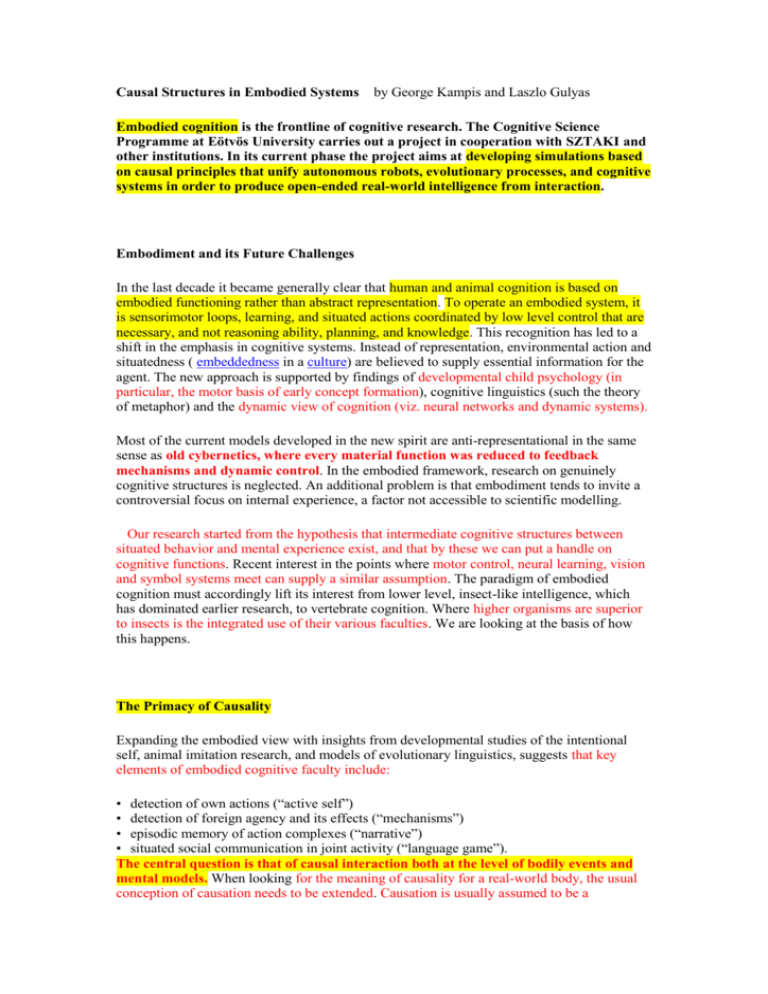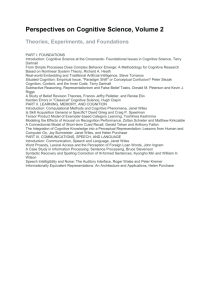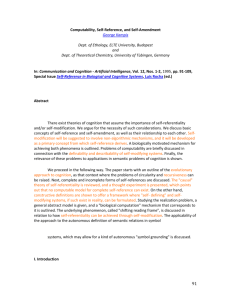Causal Structures in Embodied Systems by George Kampis and
advertisement

Causal Structures in Embodied Systems by George Kampis and Laszlo Gulyas Embodied cognition is the frontline of cognitive research. The Cognitive Science Programme at Eötvös University carries out a project in cooperation with SZTAKI and other institutions. In its current phase the project aims at developing simulations based on causal principles that unify autonomous robots, evolutionary processes, and cognitive systems in order to produce open-ended real-world intelligence from interaction. Embodiment and its Future Challenges In the last decade it became generally clear that human and animal cognition is based on embodied functioning rather than abstract representation. To operate an embodied system, it is sensorimotor loops, learning, and situated actions coordinated by low level control that are necessary, and not reasoning ability, planning, and knowledge. This recognition has led to a shift in the emphasis in cognitive systems. Instead of representation, environmental action and situatedness ( embeddedness in a culture) are believed to supply essential information for the agent. The new approach is supported by findings of developmental child psychology (in particular, the motor basis of early concept formation), cognitive linguistics (such the theory of metaphor) and the dynamic view of cognition (viz. neural networks and dynamic systems). Most of the current models developed in the new spirit are anti-representational in the same sense as old cybernetics, where every material function was reduced to feedback mechanisms and dynamic control. In the embodied framework, research on genuinely cognitive structures is neglected. An additional problem is that embodiment tends to invite a controversial focus on internal experience, a factor not accessible to scientific modelling. Our research started from the hypothesis that intermediate cognitive structures between situated behavior and mental experience exist, and that by these we can put a handle on cognitive functions. Recent interest in the points where motor control, neural learning, vision and symbol systems meet can supply a similar assumption. The paradigm of embodied cognition must accordingly lift its interest from lower level, insect-like intelligence, which has dominated earlier research, to vertebrate cognition. Where higher organisms are superior to insects is the integrated use of their various faculties. We are looking at the basis of how this happens. The Primacy of Causality Expanding the embodied view with insights from developmental studies of the intentional self, animal imitation research, and models of evolutionary linguistics, suggests that key elements of embodied cognitive faculty include: • detection of own actions (“active self”) • detection of foreign agency and its effects (“mechanisms”) • episodic memory of action complexes (“narrative”) • situated social communication in joint activity (“language game”). The central question is that of causal interaction both at the level of bodily events and mental models. When looking for the meaning of causality for a real-world body, the usual conception of causation needs to be extended. Causation is usually assumed to be a relationship between events. This is a simplification which has its origin in the abstract representational conception. Any realized action involves activities that take place in several parallel layers. In other words, causality has “depth”. One form in which causal depth can be approached is via supervenient levels acting permanently together. Our interest lies in the more dynamic ways in which various causal modes influence each other. An example is the role of different sensory modalities in active perception, where, for instance, a visually guided mental model can recursively enact actions that approach the signal and lead to new percepts that help stabilizing the mental model. The underlying concept is that of the complex body with causal faculties that are context-dependent. An Application: Evolutionary Technology The example on which we have chosen to illuminate the framework is evolution. To free ourselves from biological details the problem we consider is not natural evolution but evolutionary technology. The ultimate goal is to develop artificial organisms which perform increasingly complicated tasks. We are currently in the process of developing a simple testbed of causal principles. Evolution and cognition have striking parallels. In both cases it is complex bodily properties of a physically realized agent that collectively determine a historical process of structure formation, which we often view from the perspective of its end results, i.e., “genetic information” or “mental representation”. If we want to understand the origin of the inner structure and the role real-world causality plays in it, evolution is a good starting point. Evolution is also a useful example because equipping abstract systems with causal powers may help us understand what makes an evolutionary process work. Selection is only half of the answer, as was recently demonstrated by studies on robotic as well as software-based systems, which all failed to improve beyond a point. Looking for the cues, the lack of feedback from products to the very evolutionary process was recognized by some leading authors. As a byproduct of the cognitive theory, causality has new suggestions here. The same causal principle that helps active perception now helps selection. The assumption is that adaptation that produces new phenotype also switches the interactions between organisms to a different causal mode, making a new adaptive process possible. Evolutionary processes, as understood in the model, have the following characteristics: • phenotypic determination (i.e. interactor-based selection) • sexual and ecological modes of selection (i.e. preferential mating and food specificity) • emergent selection modes by phenotype expansion. Our simulation studies have been using the RePast system of the University of Chicago. The first results have been recently reported. Some steps of the ongoing research outlined in this article have been carried out while Prof. Kampis’s was Fujitsu Visiting Associate Professor at the Japan Advanced Institute of Science and Technology and during Dr. Gulyas’s visit at Harvard’s Center for Basic Research in the Social Sciences (CBRSS). A cooperation partner is the Center for Complex Systems Studies (CCSS) at Kalamazoo College, USA. Links http://hps.elte.hu/~kampis/projects/EvoTech.html http://www.jaist.ac.jp/~g-kampis/ http://www.sztaki.hu/~gulyas/indexE.html http://www.cbrss.harvard.edu/people/gulyas.htm http://www.kzoo.edu/physics/ccss/research.html http://repast.sourceforge.net/ Please contact: George Kampis, Eötvös University E-mail: gk@hps.elte.hu








